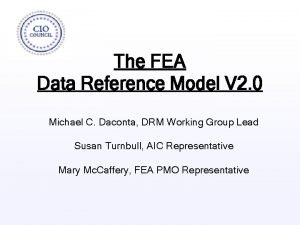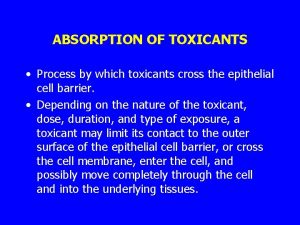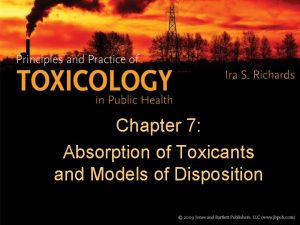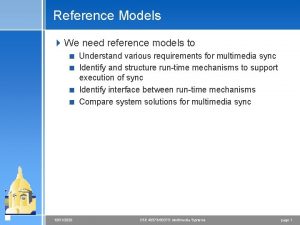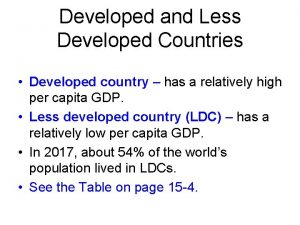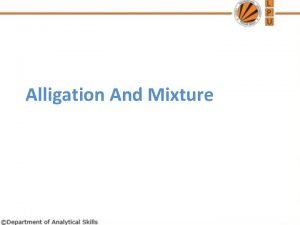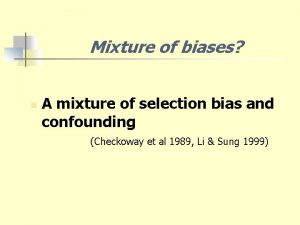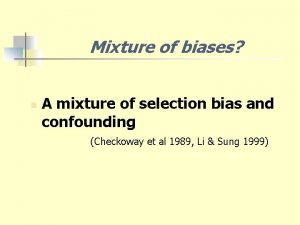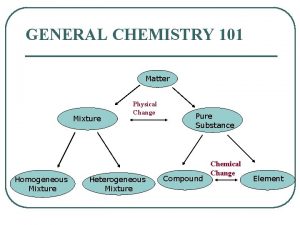Reference mixture models developed for chemical toxicants work



















- Slides: 19

Reference mixture models developed for chemical toxicants work when radionuclides are in the mix C. Svendsen, N. Horemans, C. Bradshaw, H-C. Teien, R. Gilbin, A. Margerit, F. Nascimento, H. Vandenhove, S. Lofts, D. Spurgeon, STAR final dissemination Event, Aix-en-Provence, 9 -11 June 2015 www. star-radioecology. org www. radioecology-exchange. org Supported by the European Commission, contract number: Fission-2010 -3. 5. 1269672, and the Research Council of Norway, contract number: 209101.

Objectives- What to expect from joint stressor effects? • What does “joint effect of mixtures” really mean? • Reference models developed for chemicals – IA (RA) & CA • Example of U x Cd mixture analysis – general pattern found • What models can be used when one stressor is not a chemical? • Gamma x Cd mixture analysis – general patterns found • General conclusions and other options e. g. DEB www. star-radioecology. org www. radioecology-exchange. org

What does “joint effect” really mean? • How do we work out what happens if we mix these two EC 50 s? www. star-radioecology. org www. radioecology-exchange. org

Possible models for expected joint action of mixtures: • General mistake - “Effect addition” (aka “Response Addition”) • Dissimilar acting compounds → “Independent Action” (aka “Response Addition”) • Similar acting compounds → “Concentration Addition” Effect Addition (aka Response Addition) • • • LC 25 + LC 25 = LC 50 LC 40 + LC 40 = LC 80 LC 50 + LC 50 = LC 100 LC 40 + LC 40 = LC? ? 5 x LC 50 = LC? ? Shame mixture: 2 x Uranium LC 25 = LC 50? ? LC 25=2500 2 x LC 25=5000 LC 25=2700

Possible models for expected joint action of mixtures: • General mistake - “Effect addition” (aka “Response Addition”) • Dissimilar acting compounds → “Independent Action” (aka “Response Addition”) • Similar acting compounds → “Concentration Addition” So what should we expect from 2 x LC 50? • Logically 2 x LC 50 = Effects bigger than 50% Mortality, but how big? [Chemical 2] Exposure in sequence [Chemical 1]

Possible models for expected joint action of mixtures: • General mistake - “Effect addition” (aka “Response Addition”) • Dissimilar acting compounds → “Independent Action” (aka “Response Addition”) • Similar acting compounds → “Concentration Addition” So what should we expect from 2 x LC 50? • Logically 2 x LC 50 = Effects bigger than 50% Mortality, but how big? [Chemical 2] Exposure together Probability of surviving both chemicals: Emix = Ea+Eb-(Ea*Eb) 1 -Emix = (1 -Ea)*(1 -Eb) = Q(unaff)mix [Chemical 1]

Dissimilar acting compounds → “Independent Action” (IA) • Developed in 1939 by Bliss • Based on effects of chemicals being statistically independent • I. e. It is a measure of the joint probability of effect from all the chemicals • “Russian roulette with multiple guns!” you need to be lucky every time to survive – you only get killed once, but that is also enough. • How do we assess the risk (h)? ? www. star-radioecology. org www. radioecology-exchange. org “unaffected fractions”

Dissimilar acting compounds → “Independent Action” (IA) Or simply; The probability of surviving = Prob(Surv Tox(1)) * Prop(Surv Tox(2))*…*(Prob(Surv Tox(n)) Analysis: Prob. of surviving: qmix(2 x. LC 50) = 0. 5 * 0. 5 = 0. 25 => Prob. Death = 1 – 0. 25 = 0. 75 Prediction: What Mixture gives an EC 50? q 1 * q 2 = 0. 5, If equitoxic mixture (i. e. q 1=q 2) => q 1 = q 2 = SQRT(0. 5) = 0. 71 - Need only individual effects So probability of no effect from each chem = know 0. 71 => Prob effect = 1 to - analy 0. 71 = 0. 29 - Need full dose response profiles to predic So for IA 2 x LC 29 => mix LC 50 www. star-radioecology. org www. radioecology-exchange. org

Similar acting compounds → “Concentration Addition” (CA) • Developed in 1926 by Loewe and Muischnek • Based on chemicals having same mode of action • I. e. acting on same biological pathway and strictly speaking on the same molecular target • Only difference is the relative potency of chemicals – act as “dilutions of each other” • How do we assess the risk? ? TU = Toxic Unit - So what does that mean? www. star-radioecology. org www. radioecology-exchange. org

Similar acting compounds → “Concentration Addition” (CA) A binary mixture follows CONCENTRATION ADDITIVITY IF When mixture causes 50% effect, X = 50 M = C 1/EC 501 + C 2/EC 502 = 1 Analysis: If 50% effect is caused by a mixture with “M” other than 1 => non concentration additivity: 1) M = 1, toxicants are concentration additive 2) M < 1, toxicants more than concentration additive (Synergism) 3) M > 1, toxicants less than concentration additive (Antagonism) Prediction: 50% Effect from: 1/2 EC 50 + 1/2 EC 50, 1/4 EC 50 + 3/4 EC 50, 1/6 EC 50 + 5/6 EC 50 25% Effect from: 1/2 EC 25 + 1/2 EC 25, 1/4 EC 25 + 3/4 EC 25, 1/6 EC 25 + www. star-radioecology. org 5/6 EC 25 www. radioecology-exchange. org

Concentration Addition (CA) for a mixture response surface We need ISOBOLs = “line of same value” (e. g. weather charts, soil conc. , etc. ) www. star-radioecology. org www. radioecology-exchange. org

Concentration Addition (CA) for a mixture response surface For a binary mixture that follows ADDITIVITY: M = C 1/EC 501 + C 2/EC 502 = 1 (The EC 50 Isobol) EC 50 0+1=1 ¼+¾=1 [Chem 2] EC 502 ½+½=1 ¾+¼=1 1+0=1 [Chem 1] EC 501 www. star-radioecology. org www. radioecology-exchange. org

Comparing CA and IA isobols Unless slopes < 1. 3 CA generally conservative over IA www. star-radioecology. org www. radioecology-exchange. org

Comparing data against CA and IA predictions To calculate the predicted effects to compare data against: CA: We need full DRCs to allow calculation of all single chem ECx values IA: We need the effects caused by the individual chemicals in each mixture (DRC ideal, but not needed if design is factorial) Determining if data follows the simple principles of CA or IA, lies between them, or there is overt Synergy or antagonism, is not too hard . . BUT, a good guide motto for all natural philosophers is, "Seek simplicity

More detailed testing of data against CA and IA predictions Add parameter “a” 1) CA & IA Add parameter “b” 2) S/A 3 A) DL or 3 B) DR Jonker, et. al. 2005, ET&C, 24: 2701 -2713: “MIXTOX model”

Conclusions STAR U x Cd mixture experiments across Species • L. minor: antagonism identified compared to CA or IA • S. salar: antagonism identified compared to IA • C. elegans: strong antagonism identified compared to CA and IA additivity In most cases there is a dose ratio deviation with Antagonism generally strongest where Cd dominates toxicity. www. star-radioecology. org www. radioecology-exchange. org

What model if one stressor is not a chemical (and have little effect)? Example of STAR Gamma x Cd mixture with Daphnia. Addition” “Concentration • Assumptions: • • The chemicals have same mode of action (same biological pathway / molecular target) Only difference is the relative potency of chemicals → “dilutions of each other” • Needs: Dose Response Curves (DRC) for both compounds to allow full analysis “Independent Action” • Assumptions: • Based on effects of chemicals being statistically independent - joint probability of effect • Needs: Effects know for the individual stressors being mixed (including no effect) Gamma - not a chemical, no effects (or DRC) obtainable for some www. star-radioecology. org www. radioecology-exchange. org endpoints )

Conclusions STAR Gamma x Cd mixtures across Species • L. minor: antagonism identified compared to IA (and CA) • D. magna: antagonism identified compared to IA • P. Subcapitata: antagonism identified compared to IA Conclusions STAR Gamma x FA mixtures across Species • D. magna: Effects were relatively well described by IA www. star-radioecology. org www. radioecology-exchange. org

Main conclusions and highlights • The mixture reference models of CA and IA applies as well to radioecotoxicology as any other field of ecotoxicology • Both CA and IA reference models often were close to observed effects • Ignoring the “joint effects” would seriously underestimate effects • The deviations seen generally had the same patterns across species: • U x Cd – mainly antagonism (especially where Cd dominates toxicity) • Gamma x Cd – mainly antagonism at high dose levels, BUT with some general evidence of synergy at lower doses. • Gamma x FA – Close to IA • The deviations from the mixture models were of a level that has significance in biological terms – Possible to integrate these using DEB. • Even where full effects curves could not be obtained for e. g. Gamma the IA model could still be used as a mixture reference model for joint effect • Needs factorial designs www. star-radioecology. org www. radioecology-exchange. org
 Is windex homogeneous or heterogeneous
Is windex homogeneous or heterogeneous Remedial group social work
Remedial group social work Training gaussian mixture models at scale via coresets
Training gaussian mixture models at scale via coresets What is modals and semi modals
What is modals and semi modals Fea reference models
Fea reference models Reference node and non reference node
Reference node and non reference node Reference node and non reference node
Reference node and non reference node Kontinuitetshantering
Kontinuitetshantering Novell typiska drag
Novell typiska drag Nationell inriktning för artificiell intelligens
Nationell inriktning för artificiell intelligens Ekologiskt fotavtryck
Ekologiskt fotavtryck Shingelfrisyren
Shingelfrisyren En lathund för arbete med kontinuitetshantering
En lathund för arbete med kontinuitetshantering Adressändring ideell förening
Adressändring ideell förening Tidbok yrkesförare
Tidbok yrkesförare Sura för anatom
Sura för anatom Vad är densitet
Vad är densitet Datorkunskap för nybörjare
Datorkunskap för nybörjare Stig kerman
Stig kerman Mall debattartikel
Mall debattartikel




